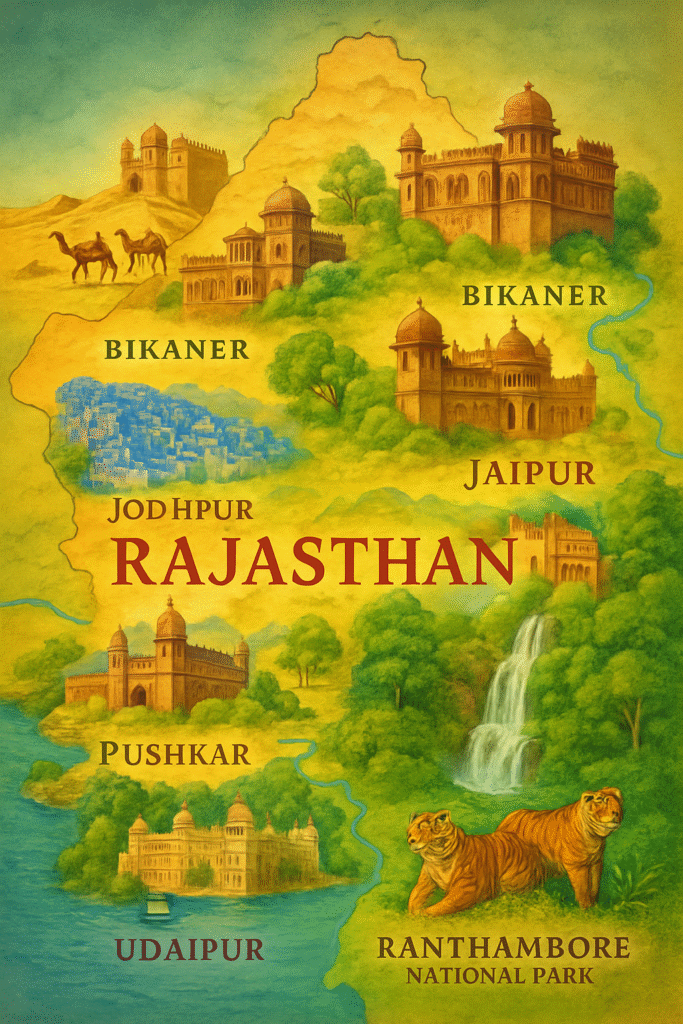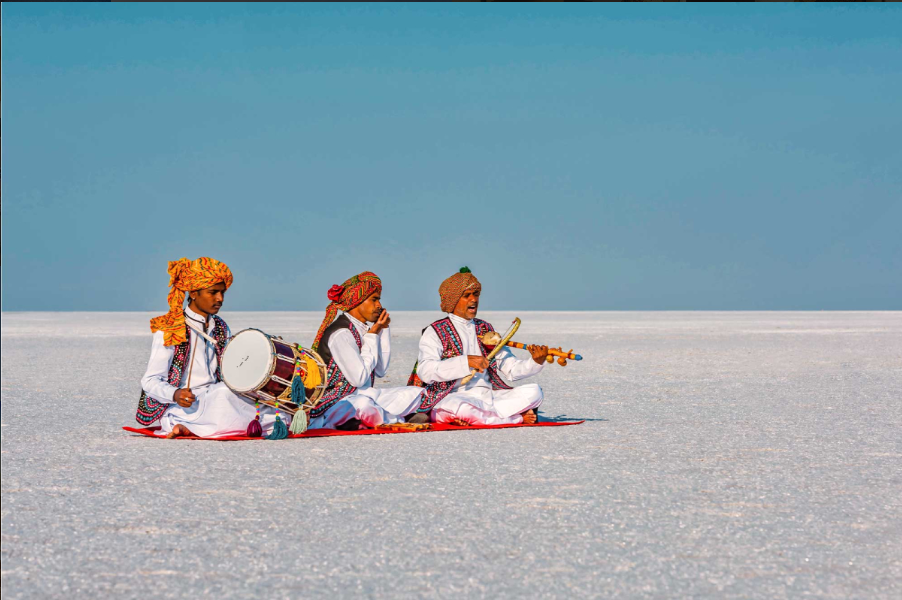Overview
Rajasthan – the “Land of Kings” – is a top destination for foreign travelers in India. Beyond Jaipur (which is part of the Golden Triangle), the state offers a circuit of historic cities and desert landscapes that showcase India’s royal heritage and colorful culture. A common extended itinerary spends ~2 weeks exploring Rajasthan, including Jodhpur (the Blue City), Udaipur (the City of Lakes), and Jaisalmer (the Golden City in the Thar Desert), in addition to Jaipur. Some routes also add Pushkar (a holy town with a famous camel fair), Bikaner, or Ranthambore (for tiger safari). This itinerary immerses visitors in Maharaja palaces, forts, and vibrant bazaars across the state.
Rajasthan’s popularity among foreigners stems from its rich history, well-preserved architecture, and romantic allure – it’s often considered quintessential India, with turbaned villagers, camels, and grand forts. In fact, Rajasthan is noted as “one of the most famous destinations in India, especially among foreign travelers” due in part to the Golden Triangle’s inclusion of Jaipur and the state’s royal legacy.

Typical route
Many start from Delhi or Jaipur. From Jaipur, one can do a loop or one way westward. A common route is: Jaipur → Jodhpur → Jaisalmer → Udaipur → back to Delhi/Jaipur. Alternatively, Jaipur → Pushkar → Jodhpur → Udaipur (skipping far west Jaisalmer if time is shorter). If coming from Agra, travelers sometimes go Agra → Jaipur then onward.
Key stops:
• Jaipur: Amber Fort, City Palace, Hawa Mahal, markets (as per golden triangle itinerary).
• Pushkar (optional): A small sacred town around Pushkar Lake with hundreds of temples (including the rare Brahma Temple) and a hippie vibe. Known for the annual Pushkar Camel Fair each November which draws many tourists. Pushkar can be done as a day-trip or overnight from Jaipur (3-hour drive).
• Jodhpur: Famous for the Mehrangarh Fort, one of India’s most impressive fortresses towering over the blue-painted old city. Also Jaswant Thada (marble cenotaph), Umaid Bhawan Palace (part luxury hotel, part museum), and the lively Sardar Market by the iconic clock tower.
• Jaisalmer: A medieval sandstone fort city on the edge of the Thar Desert. Many stay in hotels inside the living fort or havelis outside. Highlights: Jaisalmer Fort with its Jain temples, the ornate havelis (merchants’ mansions) like Patwon-ki Haveli, and desert safari – camel rides or overnight camps on the sand dunes at Sam or Khuri for a taste of the desert night sky.
• Udaipur: A picturesque city built around Lake Pichola and Lake Fateh Sagar. Attractions include the City Palace of Udaipur, Jagdish Temple, boat rides to Jag Mandir, and the Monsoon Palace on a hilltop. It’s known for romantic ambiance, boutique lakeside hotels and traditional dance performances.

• Bikaner (optional): Another desert city with Junagarh Fort and the famous Karni Mata “rat temple” nearby. Often visited by those going by road from Delhi into Rajasthan.
• Ranthambore National Park (optional detour): Many Golden Triangle or Rajasthan tours slip in 2 nights at Ranthambore (near Sawai Madhopur, between Jaipur and Agra) for jeep safaris to see tigers (more on this in the Wildlife itinerary below).
• Shekhawati region (optional): Northern Rajasthan area (e.g., Mandawa) famed for old painted havelis, sometimes on route from Delhi to Jaipur.
This itinerary is quite modular; travelers pick based on interests and days available.
Travel between locations:
The distances are longer than the core Triangle, but still very doable. Private car with driver is a popular choice to cover Rajasthan, for the freedom to stop in villages or take backroads. Drives:
Jaipur–Jodhpur (~5–6 hours, 330 km),
Jodhpur–Jaisalmer (5 hours, 280 km),
Jodhpur–Udaipur (5–6 hours, 250 km),
Udaipur– Jaipur (~7 hours, 400 km).
There are also decent train connections: e.g., high-speed train Jaipur→Jodhpur (~5 hrs), an overnight train Jaisalmer→Jodhpur or Jaisalmer→Jaipur, and a Jaipur→Udaipur train. Travelers often mix and match (e.g., take a train for one leg and car for others). Trains and buses are extensive in Rajasthan, but trains are preferred by many for comfort and the classic experience. Jodhpur, Udaipur, Jaipur, and Jaisalmer all have airports with some flights (for instance, there are short flights like Udaipur→Jaipur or Jaisalmer→Delhi on certain days), which can cut travel time if budget permits.
Within cities: auto-rickshaws are ubiquitous, and many sites (especially forts) require short drives or rides up hills. You have OLA and UBER in many cities.
Seasonal considerations:
The climate in Rajasthan is desertic and extreme. The best time is winter (Nov–Feb) when days are pleasantly warm (20–28°C) and nights cool/cold (can drop to 5°C in desert nights). December–January are peak tourist months with many European visitors – expect higher hotel rates then. By March, it heats up though still okay; April–June are very hot and dry – temperatures in Jaisalmer and Jodhpur regularly exceed 40–45°C. Sightseeing under the midday sun at that time is quite challenging.
Monsoon(July–September) brings relief in some parts: while Rajasthan doesn’t get heavy rainfall like tropical areas, Udaipur and Jaipur do get moderate rain. The landscape turns a bit green, and Udaipur’s lakes fill up. Jaisalmer sees very little rain even in monsoon. Travelers in monsoon enjoy fewer crowds and the romance of rain on palace rooftops; just note some rural roads might get muddy or a desert safari could get a rare sprinkle. The Pushkar Camel Fair is in November (on the full moon of Kartik month) which is an amazing cultural event but causes a spike in tourist numbers – advance booking is a must if coming then. You can check in India fest app or Travebrate site, for Pushkar Camel Fair. We prepare special Itineraries for these events.
Pros:
Why do this circuit? It offers an immersive journey through India’s royal history and desert culture. You see a great variety within one state: from the lake palaces of Udaipur to the golden dunes of Jaisalmer. Architecture lovers will marvel at the massive forts and opulent palaces in each city. The photo opportunities are fantastic (each city is associated with a color – Jaipur’s pink hues, Jodhpur’s blue houses, Udaipur’s white marble, Jaisalmer’s golden sandstone). Rajasthan also gives chances for unique experiences: boutique heritage hotels (sometimes former palaces or mansions) where you can literally live in history, folk music and dance performances, camel treks, and handicraft shopping (textiles, jewelry, pottery) are all big draws. The state is well set up for tourism; English is understood at tourist spots and many people in hospitality speak some foreign languages due to the volume of European tour groups. Cuisines in Rajasthan are rich but also often catered to tourists (and international options available in cities). The cultural richness and hospitality of Rajasthan leave a strong impression on visitors – many consider it the highlight of their India trip.
Cons:
Covering so much of Rajasthan means a lot of travel time – you’ll be packing and moving cities frequently. Some journeys can be long drives through arid terrain which might get tedious (though the highways are generally decent). If one tries to cram too many stops, it can feel rushed. Also, note that Rajasthan’s popular spots are no strangers to tourism – expect plenty of other tourists and the commercialization that comes with that.
Another consideration: by focusing only on Rajasthan’s royal cities, you might miss other aspects of India (like the jungles or the coastal areas or festivals). It can also be an intense two weeks of fort-and-palace sightseeing – magnificent but possibly repetitive for some; it’s good to mix activities (like a cooking class in Jaipur or a village tour near Jodhpur) to break the museum/monument monotony. Summer travel is a big con – it’s just too hot to be enjoyable, so it’s not recommended outside of October– March except for those accustomed to heat.
Guide availability:
Excellent. Rajasthan probably has the best network of licensed guides and tour escorts in India, given its tourism volume. All major cities (Jaipur, Jodhpur, Udaipur, Jaisalmer, etc.) have government-certified local guides who can be hired through the tourist offices or hotels. Many travelers opt for a hired driver-guide for the whole circuit (some drivers are knowledgeable enough to act as basic guides, though official guides are separate). At sites like Mehrangarh Fort or Udaipur City Palace, you can hire guides on the spot or use audio guides. If you stay at any heritage hotel, often they arrange curated tours or have in-house guides to show you around. It’s highly recommended to take guided walks – e.g., a heritage walk in Jodhpur’s old city or a market tour in Jaipur – to gain local insight. Language should not be an issue; guides proficient in European languages (French, Spanish, German, etc.) are also available in Rajasthan by arrangement, due to the cosmopolitan tourist mix.
Costs:
Rajasthan can cater to shoestring backpackers (who take local buses, stay in hostels or guesthouses for ₹800/night, and eat at dhabas) or luxury travelers who spend ₹20,000 a night on palace hotels – and everything in between. A realistic mid-range budget for a 10-day Rajasthan tour (with private car and driver and 3-star heritage style hotels) is around ₹10,000–12,000 ($130–160) per day for two people – so roughly $1,300–$1,600 total. This typically includes car, fuel, driver’s allowance, hotels, and breakfast. Entrance fees across all sites might add another $100+ per person (forts like Mehrangarh charge ~₹600, City Palace Udaipur ~₹500, etc.). If you do a desert camp in Jaisalmer, budget ~$50 per person for an overnight inclusive of meals and camel ride. Tipping the driver at trip’s end (around ₹500–₹1000 per week) and small tips to hotel staff or guides are customary. There are also luxury group tours – e.g., some 14-day luxury Rajasthan packages run $2500+ per head. On the other hand, independent backpackers taking trains and cheap stays could manage the 2 weeks for under $500. Rajasthan has a range of accommodations: you can find hostels for $10, charming havelis (heritage mansions) for $40–$60, or ultra-luxury like the Lake Palace in Udaipur for $300+. Government-approved guides cost around ₹1,000–2,500 per city tour. Overall, Rajasthan offers high value – even mid-range tourists often get to stay in atmospheric historic properties and dine like royalty for moderate prices, which is a big part of the appeal.


